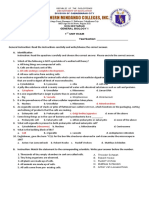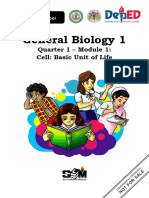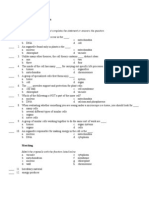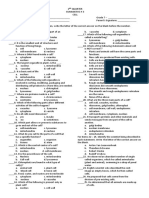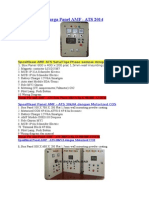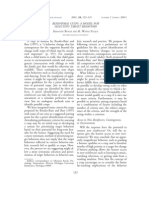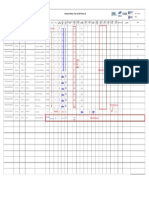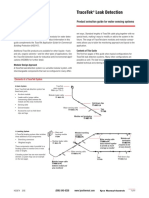SCIENCE 7 2nd Midterm
SCIENCE 7 2nd Midterm
Uploaded by
juliusvaldez07201996Copyright:
Available Formats
SCIENCE 7 2nd Midterm
SCIENCE 7 2nd Midterm
Uploaded by
juliusvaldez07201996Copyright
Available Formats
Share this document
Did you find this document useful?
Is this content inappropriate?
Copyright:
Available Formats
SCIENCE 7 2nd Midterm
SCIENCE 7 2nd Midterm
Uploaded by
juliusvaldez07201996Copyright:
Available Formats
Diocesan Schools of Urdaneta
ST. PHILOMENA’S ACADEMY
Pozorrubio, Pangasinan
MIDTERM EXAMINATION
SCIENCE 7
Name: ____________________________________ Grade & Section: ________ Score: _______
I. Multiple Choice. Write the letter of your choice on the space provided before each number.
____1. It is a tool used to view objects too small to be seen with naked eye.
A. Eyeglass B. Telescope C. Microscope D. Magnifying Glass
____2. It is a mechanical part od Microscope that is attached to the upper part of the body tube that holds the
ocular lens.
A. Draw Tube B. Arm C. Base D. Stage
____3. It is a flat platform where the specimen slide is placed.
A. Stage clip B. Base C. Mirror D. Stage
____4. Which of the following levels of biological organization describes as the basic unit of life?
A. Cell B. Tissues C. Organ D. Organ Systems
____5. Who was the first person to observed living cells?
A. Rudolf Virchow B. Theodor Schwann
C. Robert Hooke D. Anton van Leeuwenhoek
____6. Who discovered the cell?
A. Rudolf Virchow B. Theodor Schwann
C. Robert Hooke D. Anton van Leeuwenhoek
____7. This are rodlike structures located within the microtubule of an animal cell.
A. Centriole B. Cell Wall C. Vacuoles D. Mitochondria
____8. Which of the following organelles has a function of storage center cell’s DNA?
A. Cytoplasm B. Nucleus C. Vacuoles D. Mitochondria
____9. It is the boundary around the plant cell outside of the cell membrane that provides structure and support?
A. Cytoplasm B. Nucleus C. Cell Wall D. Mitochondria
____10. It is a gelatin-like fluid that lies inside the cell membrane and contain salt, mineral and organic
molecules?
A. Cytoplasm B. Nucleus C. Cell Wall D. Mitochondria
____11. It refers to a stacked flat sacs and receives proteins from endoplasmic reticulum and distributes them to
other organelles or out of the cell.
A. Nucleus B. Golgi Apparatus C. Cell Wall D. Cell Membrane
____12. It converts energy stored in food into usable energy for work and also called as the “POWER HOUSE
OF THE CELL”?
A. Nucleus B. Mitochondria C. Cell Membrane D. Nucleus
____13. A spherical organelles that contains hydrolytic enzymes within single membranes and breaks down
food particles, invading objects.
A. Mitochondria B. Cell Wall C. Nucleus D. Lysosomes
____14. It is a hair-like organelles that extend from the surface of cells.
A. Mitochondria B. Flagella C. Nucleus D. Lysosomes
____15. Refers to a cell component that performs specific functions in the cell.
A. Nucleus B. Organelle C. Eukaryotes D. Prokaryotes
II. Identification. Identify the following levels of biological organization.
______________1. The Earth’s zone of air, soil, and water that is capable of supporting life.
______________2. Also known as life zones, all plants, animals, and other organisms, as well as the physical
environment in a particular area.
______________3. It is a localized group of interdependent organisms together with the environment that they
inhabit and depend on.
______________4. Several populations living together with interaction.
______________5. It is the smallest independently functioning unit in the structure of an organism.
______________6. A large number of cells that are similar in form and function.
______________7. It is a complete and independent part of a plant or animal that has a specific function.
______________8. A group of organs that work together to carry out its functions.
______________9. Functioning system of interdependent parts that resembles a living thing.
______________10. A same type of organism living together in an area.
III. True or False. Write the word TRUE if the statement is correct, if incorrect write the word FALSE in the
space provided before each number.
__________1. The cell is the basic unit of life.
__________2. All living things are composed one or more cells.
__________3. Cells are organisms basic unit of structure and function.
__________4. Mitochondria is the powerhouse of the cell.
__________5. Cell walls are located inside the plant cell.
__________6. The smallest cell is the Bacterium.
__________7. The first microscope made by Anton Van Leuwenhoek was 6 feet long.
__________8. Cells that cover the body are considered connective tissues.
__________9. Robert Hooke observed a thin slice of cork with a telescope.
_________10. Microscope was made in 1665 by Robert Hooke.
IV. Essay. Answer the following questions.
1. What is the differences between a Simple Microscope to Compound Microscope? (5 Points)
Prepared by:
Danica F. Lorenzo
Subject Teacher
You might also like
- Fmea PumpDocument8 pagesFmea Pumpsumantabal_uceNo ratings yet
- Child and Adolescent LiteratureDocument13 pagesChild and Adolescent LiteratureJohn Rey Bandong100% (4)
- Written Work 1 CellDocument5 pagesWritten Work 1 CellAnna Liza CarrascalNo ratings yet
- SCIENCE 7 2ND QuarterDocument3 pagesSCIENCE 7 2ND Quarterjuliusvaldez07201996No ratings yet
- Msu Marantao MidtermDocument3 pagesMsu Marantao MidtermRaihana YusophNo ratings yet
- Midterm in Science 7Document3 pagesMidterm in Science 7Raihana YusophNo ratings yet
- 1ST UNIT EXAM Gen Bio 1key AnswerDocument4 pages1ST UNIT EXAM Gen Bio 1key AnswerMea-Ann OscianasNo ratings yet
- PT g7 ScienceDocument5 pagesPT g7 ScienceHAROLD MORALESNo ratings yet
- FInal Gen Bio 1Document4 pagesFInal Gen Bio 1roselyn acpacNo ratings yet
- General Biology Midterm Examination: Senior High School Department Academic Year 2021-2022Document3 pagesGeneral Biology Midterm Examination: Senior High School Department Academic Year 2021-2022Ronald ValenzuelaNo ratings yet
- Name:: Score: Quiz 1: The Microscope and The Study of The CellDocument2 pagesName:: Score: Quiz 1: The Microscope and The Study of The CellRyan BersaminNo ratings yet
- General Biology 1 TQ G12Document3 pagesGeneral Biology 1 TQ G12jonathan labajoNo ratings yet
- BIO 1 - Module 2Document22 pagesBIO 1 - Module 2mtalquisola2002No ratings yet
- SCIENCE-7-SUMMATIVE - 2nd-Q Week 1-4Document3 pagesSCIENCE-7-SUMMATIVE - 2nd-Q Week 1-4EDWIN DUMOPOYNo ratings yet
- Science 7 Las 4b CellsDocument3 pagesScience 7 Las 4b CellsRuvy Jean Codilla-FerrerNo ratings yet
- 2nd Periodical Examination in Science 7Document3 pages2nd Periodical Examination in Science 7Kaye Ochigue Galope-ObsidNo ratings yet
- Module 1Document9 pagesModule 1Ivan PaulinoNo ratings yet
- Q1 Exam Gen Bio TO PRINTDocument7 pagesQ1 Exam Gen Bio TO PRINTrey.quimno002No ratings yet
- Cells QuizDocument2 pagesCells QuizMelva GuerraNo ratings yet
- 2nd Quarter Grade 7Document2 pages2nd Quarter Grade 7Genalyn Cirpo TayoneNo ratings yet
- SCIENCE-7-SUMMATIVE - 2nd-Q Week 1-4Document2 pagesSCIENCE-7-SUMMATIVE - 2nd-Q Week 1-4EDWIN DUMOPOYNo ratings yet
- Cell QuizDocument9 pagesCell QuizAhdzorizm Plcn100% (1)
- SCIENCE 7 2nd Periodical TestDocument2 pagesSCIENCE 7 2nd Periodical TestAngelica Bacolod100% (2)
- General Biology 1 TQ G12Document3 pagesGeneral Biology 1 TQ G12jonathan labajoNo ratings yet
- General Biology 1 2023 ExamDocument22 pagesGeneral Biology 1 2023 Examrolly baloNo ratings yet
- Q1 General Biology 12 - Module 1Document25 pagesQ1 General Biology 12 - Module 1Ivy AguasNo ratings yet
- General Biology 1 Summative TestDocument2 pagesGeneral Biology 1 Summative TestCherryllyn LeonaNo ratings yet
- For PrintingDocument5 pagesFor PrintingRina RomanoNo ratings yet
- Q1 W1 M1 Biotechnology SSElectiveDocument20 pagesQ1 W1 M1 Biotechnology SSElectiveJohn Lord Jay D. SayconNo ratings yet
- G72 ND PTScienceDocument6 pagesG72 ND PTScienceRachell PobleteNo ratings yet
- Second Qaurter Exam in Science 7Document5 pagesSecond Qaurter Exam in Science 7sheila mae tadoNo ratings yet
- Biotech Q1summativeDocument2 pagesBiotech Q1summativeJeralyn Vallecer-AbelloNo ratings yet
- 2nd PT SY 2022-2023Document12 pages2nd PT SY 2022-2023Rina RomanoNo ratings yet
- Worksheet On CellsDocument6 pagesWorksheet On CellshatchdogNo ratings yet
- Q2 Periodic ExamDocument4 pagesQ2 Periodic Examevelynsevilla074No ratings yet
- Inopacan National High School Inopacan Leyte Second Quarter Examination in Science 7 Name: - Yr. & Section: - ScoreDocument2 pagesInopacan National High School Inopacan Leyte Second Quarter Examination in Science 7 Name: - Yr. & Section: - ScoreR-Yel Labrador BaguioNo ratings yet
- M1 Science Test-Cells: Multiple ChoiceDocument5 pagesM1 Science Test-Cells: Multiple ChoiceBillD100% (1)
- SCIENCE 7Document2 pagesSCIENCE 7JOHANNES MAE UNGRIANo ratings yet
- REGULAR SCIENCE 7 QUARTER EXAMINATION 50 ItemsDocument3 pagesREGULAR SCIENCE 7 QUARTER EXAMINATION 50 ItemsGojo KaisenNo ratings yet
- General Biology 1 Tissues and Cell Types Quarter 3, Module 2bDocument17 pagesGeneral Biology 1 Tissues and Cell Types Quarter 3, Module 2bSam KimNo ratings yet
- Gayong-Gayong Sur Integrated School Second Periodic Examination in Science 7 Name: - Date: - ScoreDocument3 pagesGayong-Gayong Sur Integrated School Second Periodic Examination in Science 7 Name: - Date: - ScoreLaira Joy Salvador - ViernesNo ratings yet
- Cells and Heredity Chapter 1 NotesDocument83 pagesCells and Heredity Chapter 1 Notessyang3No ratings yet
- Department of Education: Division of Batangas Rizal College of TaalDocument2 pagesDepartment of Education: Division of Batangas Rizal College of TaalJonathanNo ratings yet
- 2ND PTE ReviewerDocument2 pages2ND PTE ReviewerSumire KakeiNo ratings yet
- Multiple ChoiceDocument19 pagesMultiple ChoiceJoke JoNo ratings yet
- Biology CH 7 Practice TestDocument6 pagesBiology CH 7 Practice Testvaleria100% (2)
- Local Media4318719121422453373Document5 pagesLocal Media4318719121422453373Raquel De CastroNo ratings yet
- Cell Take Home Virtual QuizDocument3 pagesCell Take Home Virtual QuizAna Hernandez SharpNo ratings yet
- Grade 7STE Science 2nd QuarterDocument7 pagesGrade 7STE Science 2nd Quarterjovdoctolero15No ratings yet
- 2nd QT Summative Test 3 CELLDocument1 page2nd QT Summative Test 3 CELLRowena Sta MariaNo ratings yet
- Digestive System ExamDocument3 pagesDigestive System ExamRouse Leanne NicolasNo ratings yet
- 1.1 Cell Structure and FunctionDocument7 pages1.1 Cell Structure and FunctionsimbamundawararaNo ratings yet
- General Biology 1: Modified Strategic Intervention MaterialsDocument22 pagesGeneral Biology 1: Modified Strategic Intervention MaterialsKurt DimacaliNo ratings yet
- Ultiple HoiceDocument4 pagesUltiple HoiceChari MembrillosNo ratings yet
- Second Quarter Test Science 7Document4 pagesSecond Quarter Test Science 7Vhinajoana JavierNo ratings yet
- Second Quarter Test Science 7Document5 pagesSecond Quarter Test Science 7QUEENIE BUTALIDNo ratings yet
- Week 4B Science 7 LasDocument7 pagesWeek 4B Science 7 LasJonah Labine Jabulin-RadazaNo ratings yet
- Third Monthly Exam - Science 7Document2 pagesThird Monthly Exam - Science 7Agustin L. IdausosNo ratings yet
- Kami Export - MARC LOUIS - Biology Test Cell StructureDocument6 pagesKami Export - MARC LOUIS - Biology Test Cell StructureMarc LouisNo ratings yet
- 6th Grade Quarter 1 Science Exam Worksheets .Document7 pages6th Grade Quarter 1 Science Exam Worksheets .MohammadNassarNo ratings yet
- GEN BIO 1 2nd Summative QuizDocument2 pagesGEN BIO 1 2nd Summative QuizViviane O. BaylonNo ratings yet
- O Level Biology Practice Questions And Answers CellsFrom EverandO Level Biology Practice Questions And Answers CellsRating: 5 out of 5 stars5/5 (2)
- InteractionsDocument32 pagesInteractionsjuliusvaldez07201996No ratings yet
- MICROORGANISMDocument52 pagesMICROORGANISMjuliusvaldez07201996No ratings yet
- REPRODUCTION - Grade 7Document49 pagesREPRODUCTION - Grade 7juliusvaldez07201996No ratings yet
- Ohms LawDocument18 pagesOhms Lawjuliusvaldez07201996No ratings yet
- Guidelines Laro NG LahiDocument2 pagesGuidelines Laro NG Lahijuliusvaldez07201996No ratings yet
- Rizal TimelineDocument6 pagesRizal Timelinejuliusvaldez07201996No ratings yet
- MICROSCOPEDocument24 pagesMICROSCOPEjuliusvaldez07201996No ratings yet
- Science 7 3RD PrelimDocument2 pagesScience 7 3RD Prelimjuliusvaldez07201996No ratings yet
- With Experiment Final Demo JoyzeDocument7 pagesWith Experiment Final Demo Joyzejuliusvaldez07201996No ratings yet
- Science 7 Final ExamDocument4 pagesScience 7 Final Examjuliusvaldez07201996No ratings yet
- SCIENCE-8 (2nd Midterm)Document5 pagesSCIENCE-8 (2nd Midterm)juliusvaldez07201996No ratings yet
- Science 7 1ST QeDocument3 pagesScience 7 1ST Qejuliusvaldez07201996No ratings yet
- Earth Science FinalsDocument3 pagesEarth Science Finalsjuliusvaldez07201996No ratings yet
- Gen Chem 1ST QuarterlyDocument3 pagesGen Chem 1ST Quarterlyjuliusvaldez07201996No ratings yet
- Prelim Earth ScienceDocument2 pagesPrelim Earth Sciencejuliusvaldez07201996No ratings yet
- Earth Science MidtermDocument2 pagesEarth Science Midtermjuliusvaldez07201996No ratings yet
- On Lean ManufacturingDocument9 pagesOn Lean ManufacturingDipjoy Das88% (16)
- Shenyang Aerospace Mitsubishi Motors Engine Manufacturing Co., LTDDocument167 pagesShenyang Aerospace Mitsubishi Motors Engine Manufacturing Co., LTDAbel OviedoNo ratings yet
- UT Dallas Syllabus For Husl6390.001.10f Taught by Patricia Michaelson (Pmichael)Document3 pagesUT Dallas Syllabus For Husl6390.001.10f Taught by Patricia Michaelson (Pmichael)UT Dallas Provost's Technology GroupNo ratings yet
- M-Pro MobileDocument4 pagesM-Pro MobileDrakkarNo ratings yet
- Pre-Writing Strategies PPT SimpleDocument18 pagesPre-Writing Strategies PPT Simpleanitamartinez0% (1)
- Can AnalyzerDocument39 pagesCan Analyzerallaboutanalog100% (1)
- Harga Panel AMFDocument4 pagesHarga Panel AMFBobby Underscore TanggerNo ratings yet
- Rating Sheet: National Assessment ForDocument8 pagesRating Sheet: National Assessment ForShela mae salmoNo ratings yet
- UNIT 1 Englis BusinessDocument11 pagesUNIT 1 Englis BusinessBudiarti PutriNo ratings yet
- Cluster Could Not StartDocument4 pagesCluster Could Not StartMartaSekulicNo ratings yet
- Form Pengisian Insentif - 2024Document11 pagesForm Pengisian Insentif - 2024slontong705No ratings yet
- International Business: by Charles W.L. HillDocument37 pagesInternational Business: by Charles W.L. HillLa La Sha La LaNo ratings yet
- Business AssignmentDocument4 pagesBusiness Assignmenteemail4youuNo ratings yet
- User Manual XR 6000Document236 pagesUser Manual XR 6000VremedSoluCiones75% (4)
- Holistic Marketing of Dance Therpy PDFDocument14 pagesHolistic Marketing of Dance Therpy PDFkarinadapariaNo ratings yet
- Video Fundamentals: Signal Processing For Digital TVDocument86 pagesVideo Fundamentals: Signal Processing For Digital TVAndrewWerdnaNo ratings yet
- Fee Structure 2021Document5 pagesFee Structure 2021lethabozitha41No ratings yet
- Lesson Plan 14Document16 pagesLesson Plan 14Jay BolanoNo ratings yet
- BOSCH & FUQUA - Cusp and Target Selection - JABA - 2001 PDFDocument3 pagesBOSCH & FUQUA - Cusp and Target Selection - JABA - 2001 PDFWilly BoschNo ratings yet
- Slitting MachineDocument3 pagesSlitting MachineMasthan GMNo ratings yet
- Instrument Alarms, Trips and Set Points List: 0 1980 RPM 1980 RPM VAIDocument1 pageInstrument Alarms, Trips and Set Points List: 0 1980 RPM 1980 RPM VAInastyn-1No ratings yet
- Returns To Buying Winners and Selling Lose RS: Implications For Stock Market EfficiencyDocument48 pagesReturns To Buying Winners and Selling Lose RS: Implications For Stock Market Efficiencymuath alzahraniNo ratings yet
- Vocabulary Ladders - Grade 6 - Attitude or AppearanceDocument6 pagesVocabulary Ladders - Grade 6 - Attitude or AppearancefairfurNo ratings yet
- ACT Report - Goulburn TRS Insulation - Jemena Gas NetworksDocument17 pagesACT Report - Goulburn TRS Insulation - Jemena Gas Networksmkash028No ratings yet
- Lesson 15: Change Management in Health InformaticsDocument15 pagesLesson 15: Change Management in Health InformaticsJennifer Ledesma-Pido100% (3)
- Tracetek Leak Detection: Product Selection Guide For Water Sensing SystemsDocument4 pagesTracetek Leak Detection: Product Selection Guide For Water Sensing SystemsKaushik ButalaNo ratings yet
- Best Mobile Under 40000 in PakistanDocument42 pagesBest Mobile Under 40000 in PakistanMohammad AtherNo ratings yet
- Relations For Hydraulic Resistance in RiversDocument24 pagesRelations For Hydraulic Resistance in RiversSamuelErmiyasNo ratings yet






